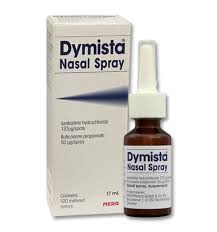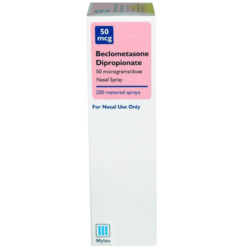
£19.85
Variety of delivery options including next day & free delivery.
Pharmacy, clinic and prescribers based in Greater Manchester.
Start your treatment with a quick and free online consultation.
 This is a prescription product.
This is a prescription product.You need to complete a consultation form and allow our pharmacists to access your NHS records for review before we can issue this treatment.
Variety of delivery options including next day & free delivery.
Pharmacy, clinic and prescribers based in Greater Manchester.
Start your treatment with a quick and free online consultation.
Fill in a quick online consultation for our licensed pharmacists to review.
Our pharmacists will review your treatment to ensure it’s suitable.
Your treatment will be delivered to your door quickly & discreetly.
Dymista Nasal Spray effectively treats moderate to severe seasonal and year-round allergies. Dymista nasal spray contains two active ingredients, azelastine and fluticasone, to ease symptoms like runny nose, sneezing, and congestion. This dual-action spray prevents allergic reactions and reduces inflammation for better relief.
You can buy Dymista Nasal Spray online from our online allergy treatment clinic. Complete a quick and free consultation to get your prescription approved by our pharmacists. Enjoy fast, discreet delivery straight to your door.
Dymista is a dual-action nasal spray that combines two medicines: azelastine, an antihistamine, and fluticasone, a steroid. Azelastine stops allergic reactions, while fluticasone reduces swelling in your nose. Together, they effectively relieve symptoms of nasal allergies.
Dymista Nasal Spray is suitable for most adults. Avoid using it if:
If you have one of the following conditions, you should speak to your GP before starting using Dymista Nasal Spray, as you may require additional monitoring:
Avoid Dymista if you are pregnant, planning on becoming pregnant, or are breastfeeding until you have spoken to your GP or Midwife.
While side effects from Dymista Nasal Spray are unlikely, they can occur. It’s important to be aware of potential reactions and consult your GP or pharmacist if you experience any unusual symptoms, including side effects not listed here.
Contact your GP or pharmacist if you experience any side effects, including those not listed here. For serious side effects, stop using Dymista Nasal Spray immediately and consult your GP, call 111, or visit the nearest Accident & Emergency department. You can also report side effects to the MHRA’s Yellow Card Scheme, which helps ensure medication safety. Reporting side effects is important for maintaining the safety of medications.
Active ingredients: Azelastine hydrochloride, fluticasone propionate.
Inactive ingredients: Disodium edetate, glycerol, microcrystalline cellulose, carmellose sodium, polysorbate 80, benzalkonium chloride, phenylethyl alcohol, purified water.
Store Dymista Nasal Spray at room temperature, below 25°C, and keep it out of sight and reach of children. Do not use it after the expiry date or if the bottle has been open for more than 6 months. Dispose of any unused spray properly, following your pharmacist’s advice
Alternatives to Dymista Nasal Spray include the following nasal sprays:
Each of these alternatives works to relieve allergy symptoms, offering different corticosteroid options for managing nasal allergy symptoms.
EXCELLENT
Dymista Nasal Spray is not an over-the-counter medicine – it requires a prescription, which can be obtained through our online allergy treatment clinic.
Most users notice improvement within a few days, but it is essential to use it regularly for the best results.
Consult your GP or Midwife before using Dymista Nasal Spray if you are pregnant or breastfeeding.
While rare, some users may experience dizziness or drowsiness. If you feel affected, avoid driving or operating machinery.
Store Dymista Nasal Spray at room temperature, below 25°C, and keep it out of sight and reach of children. Do not refrigerate or freeze.
If you miss a dose, use it as soon as you remember. If it is almost time for your next dose, skip the missed dose and resume your regular schedule. Do not double dose.
To avoid potential interactions, consult your GP or pharmacist before combining Dymista Nasal Spray with other nasal treatments.
The recommended dose is one spray into each nostril in the morning and evening. Do not exceed the recommended dosage unless advised by your GP.
Dymista nasal spray can be a real game-changer if you’re struggling with allergies. It combines an antihistamine and a steroid to tackle congestion, sneezing, and itching all at once. It’s a handy and reliable option to help you feel better fast.

Dr Hussain Ahmad
Page content authored by Mr Mohammed, last reviewed by Dr Hussain Ahmad on 20th June 2025.











